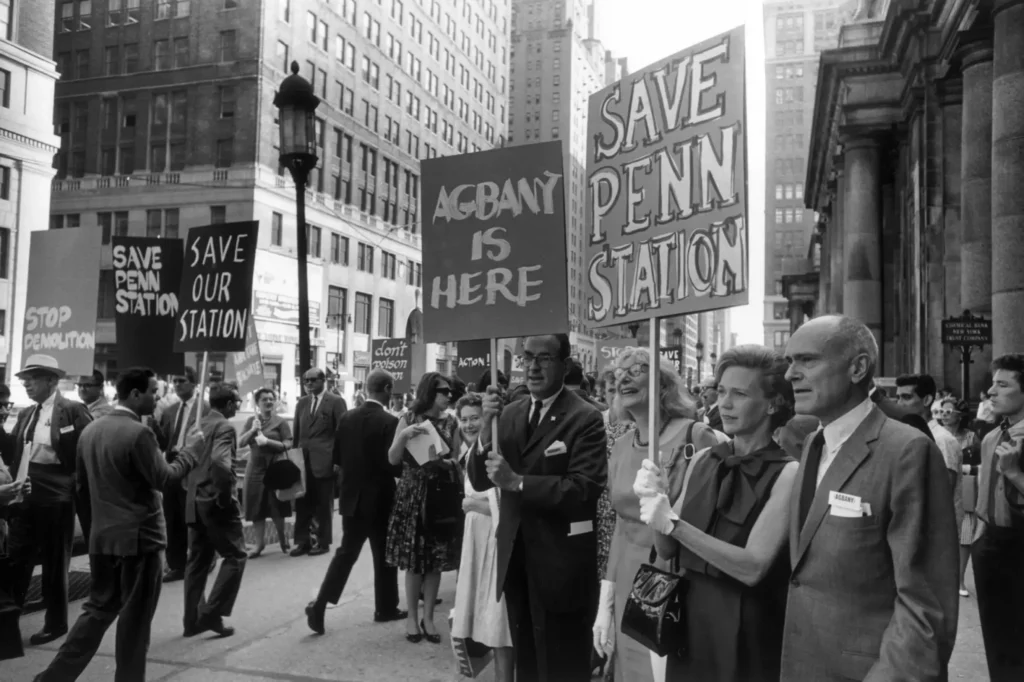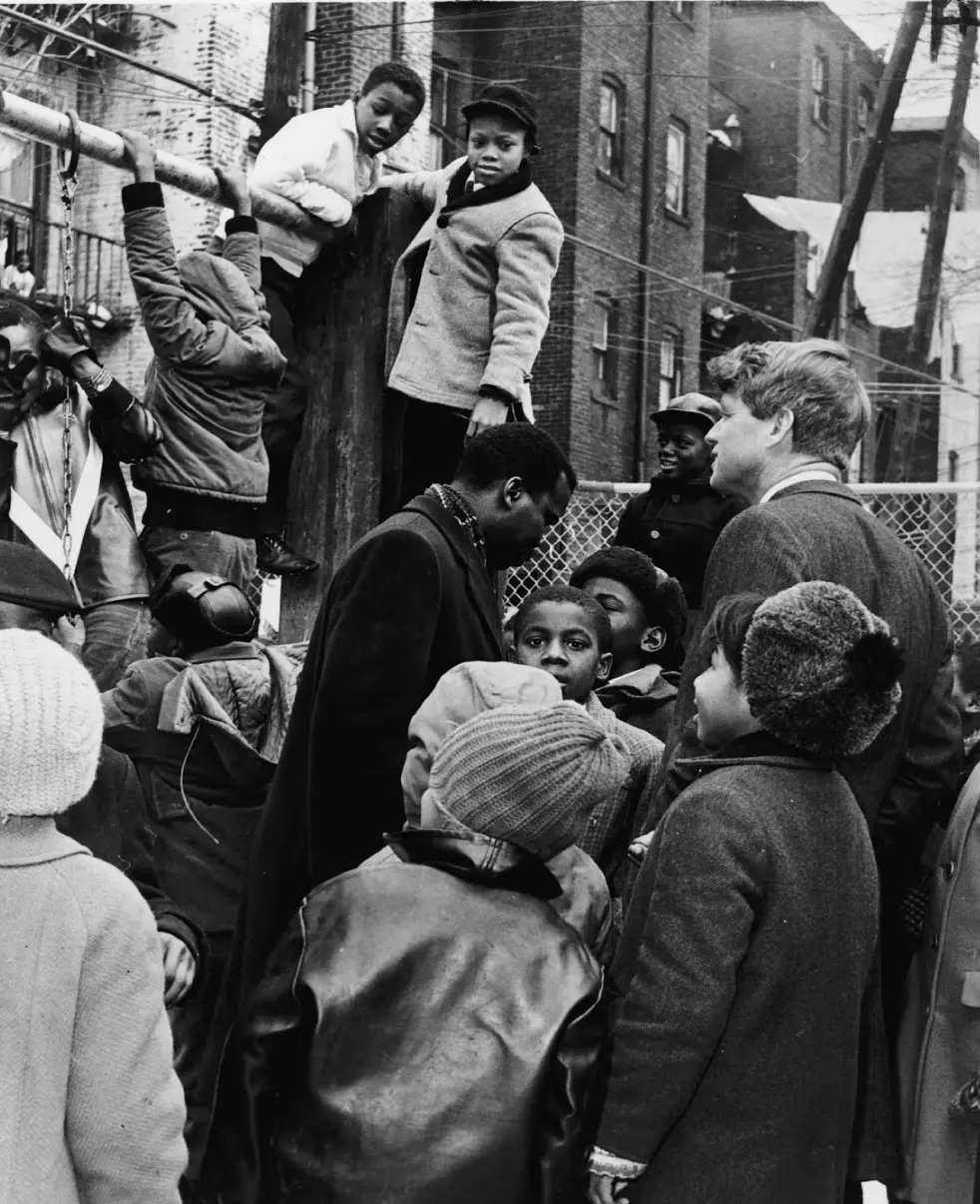Commonly Accepted Origins
From the sit-ins of the Civil Rights movement to Whitney M. Young’s speech to the AIA, the 1960s marked an era in advocacy, liberation, and transformation. In the counterculture spirit of the era, the 1960s saw the maturation and formalization of community design and development.
1963
President John F. Kennedy gets assassinated in Dallas, Texas.
1964
Civil Rights Movement

Image: Robert Abbott Sengstacke via Getty Images
The long-simmering struggles for civil rights, organized labor, and social justice came to a head in the early 1960s. Activism and organizing exploded across America through d women’s liberation, environmentalism, Chicano rights, and the anti-war movement. From Martin Luther King Jr. and Malcolm X to Cesar Chavez and Angela Davis, movement leaders presided over changing social mores and traditions, including increased education, new employment opportunities for women, and the advent of television and a visual mass-media. All these currents informed a new social consciousness growing in the United States.
The Great Society
As the Civil Rights movement grew out from sit-ins and boycotts in the South to mass marches on the Capitol in Washington D.C., anti-discrimination and anti-segregation activists won major legislative victories in 1964, 1965, and 1968. As part of these victories, President Lyndon B. Johnson committed federal resources to the elimination of poverty and racial injustice in America in service of what he called the Great Society.

Image: University of Michigan’s Bentley Historical Library
“So let your young hearts armed with new weapons join in an old battle against ancient enemies–the enemies of poverty, disease, illiteracy, strife, and bigotry. And with your courage and with your compassion and your desire, we will build the Great Society. It is a Society where no child will go unfed, and no youngster will go unschooled. Where no man who wants work will fail to find it. Where no citizen will be barred from any door because of his birthplace or his color or his church. Where peace and security is common among neighbors and possible among nations.”
President Lyndon B. Johnson, Remarks at Ohio University on May 7, 1964
Public Papers of the Presidents of the United States (Washington DC: Government Printing Office, 1967).

Image: New York City Municipal Archives
One major facet of the Great Society, which targeted inequity and poverty at its roots, was the Model Cities Program of 1966. The Economic Opportunity Act of 1964 had produced the Community Action Program (CAP), but mayors across the country were frustrated that it had removed control of funds from municipalities’ hands. The Model Cities Program was meant to address this dissatisfaction, and was initially given a budget of $2.3 billion across sixty-six cities; but the Vietnam War effort dampened the appropriation to $900 million.1
1965
Reverberations of the Watts Rebellion
On August 11, 1965, the violent arrest of Marquette Frye in Los Angeles’ Watts neighborhood sparked anger, frustration, and demands for justice, resulting in riots and property destruction. After Martin Luther King Jr. arrived in Los Angeles, he noticed the palpable discontent and realized that the Southern Christian Leadership Conference (SCLC) needed to expand northward and address the problems facing Black people in urban areas.

Image: The Bettman Archive
The Landmarks Preservation Movement

Image: Walter Darian via Getty Images
Not until after World War II did the concept of historic preservation manifest into a full-fledged movement. When large-scale destruction of historic buildings took place in the post-war redevelopment schemes did the members of the Municipal Arts Society recognize that the city’s architectural heritage and legacy was in danger. From the editorials of Ada Louise Huxtable to Kevin Lynch’s Image of the City and Jane Jacobs’ The Death and Life of Great American Cities, these texts publicized the linkages between the city’s cultural history and its neighborhoods. Architectural luminaries and the city’s public intellectuals organized to challenge the destruction of history.
Despite the loss of Penn Station, a landmarks preservation bill was passed in 1965 and designated over nineteen thousand buildings, only 2% of the city’s total buildings, and sixty historic districts. This law passed because of this small group of individuals being in the right place at the right time.2
1966
1966
More than 500,000 troops are sent to Vietnam by the Johnson administration.
RFK and the BSRC
The Watts Rebellion had ripple effects across the nation. In early 1966, Central Brooklyn Coordinating Council’s organizers Elsie Richardson and Donald Benjamin led Senator Robert F. Kennedy on a tour of Bedford-Stuyvesant, a primarily African American neighborhood dealing with the issues of disinvestment and displacement. Kennedy was the first politician in years to be interested in seeking a solution to the problem of black inner-city poverty. He believed that ‘wiping out the ghetto was essential to the future of the Negro and the city itself.’ This required a mobilization of those on the ground to achieve a ‘total regeneration.’
Mayor John Lindsay, Senator Jacob Javitz, and Senator Kennedy collaborated to use the Special Impact Program’s funding under the Economic Opportunity Act to create the community development corporation model. The Bedford-Stuyvesant Restoration Corporation (BSRC) and the Development Services Corporation (DSD) were the first examples. Additional funding for the BSRC came from the Taconic Foundation, the Rockefeller Foundation, the Stern Family Fund, the J.M. Kaplan Fund, and the Ford Foundation.3

Image: Dick DeMarsico via the Library of Congress
The BSRC leveraged the investors in its project to support economic development in the community. One example involved IBM’s decision to locate a computer component assembly plant in the neighborhood, which later grew and expanded with workers being trained in and recruited from Bedford-Stuyvesant. As the community development corporation model flourished and became replicated in other cities, another type of organization was beginning to materialize: the community design center.
Central Brooklyn Coordinating Council

Robert F. Kennedy

Bedford Stuyvesant Restoration Corporation

Development Services Corporation
Taconic Foundation

Edgar Stern Family Fund

JM Kaplan Fund

Rockefeller Foundation

Ford Foundation

The Other CDC: Community Design Center
The ‘community design center’ model came out of urban professionals’ desire to provide technical services like design, planning, and pricing to neighborhoods that could not afford it. This practice promoted fairness and equality by advocating for affordable housing, better infrastructure, and access to amenities.
This era of community design centers is often referred to as the Idealistic Period — a moment when professionals left academia to work in the communities with utopian ideals. The early activities of Architects’ Renewal Committee in Harlem (ARCH) in Manhattan, Pratt Institute’s Center for Community and Environmental Design (PICCED) in Brooklyn, Neighborhood Renewal Corps (NRC) in Philadelphia, San Francisco Community Design Center (SFCDC), and Urban Planning Aid (UPA) in Boston all shared this spirit. In addition to their idealistic values, each of these organizations also shared a common approach to participatory collaboration and research in the communities they were working in. This ethos matched the principles of advocacy planning in Paul Davidoff’s seminal 1965 text Advocacy and Pluralism in Planning.4

Image: East Harlem Triangle Plan via the Internet Archive
Architect’s Renewal Committee in Harlem

Neighborhood Renewal Corps

San Francisco Community Design Center

Urban Planning Aid

Influential works like Kevin Lynch’s The Image of the City (1960), Lewis Mumford’s The City in History (1961), Jane Jacob’s The Death and Life of American Cities (1961), Herbert Gans’ Urban Villagers (1962), Stanley Tankel’s The Importance of Open Space in the Urban Fabric (1963), and Erwin Anton Gutkind’s The International History of City Development (1964) were all published during the Sixties. Each of these texts contributed to an overall critical assessment of the status quo of architecture, design, planning, and sociology in the United States, with the backdrop of the cultural and social turmoil of the 1960s.5
“The AIA has helped develop a professional aesthetic unrelated to the real needs of people that permits sociologically disastrous housing projects and racist universities to be built. We believe architects must begin to realize they are socially responsible for their actions, that by designing buildings for oppressive institutions, they reinforce those institutions. We believe the architect must no longer be responsible only to the industrial and political powers… but to the users, the people who inhabit the environment. The architects cannot… remain aloof from people and communities, afraid to acknowledge that other men also know something about their environment, and afraid to lessen their professional distance and learn from the users.”
From the Students from Columbia, UPenn, MIT, and Harvard Walking Out on the 1968 AIA Conference
Brian Goldstein, “Planning’s End?,” Journal of Urban History 37, no. 3 (2011).
1968
1968
Dr. Martin Luther King, Jr. was shot dead while standing on a balcony outside his second-floor room at the Lorraine Motel in Memphis, Tennessee.
Whitney M. Young’s Call to Action
The culmination of this activist spirit and fervor towards the society’s inequities came to a head at the 1968 AIA Annual Convention in Portland, OR where National Urban League executive director Whitney M. Young made a charged keynote address on the practice of architecture and design with race and equity.

Image: The AIA Archives
“As a profession, you ought to be taking stands on these kinds of things. If you don’t as architects stand up and endorse Model Cities and appropriations, if you don’t speak out for rent supplements or the housing bill calling for a million homes, if you don’t speak out for some kind of scholarship program that will enable you to consciously and deliberately seek to bring in minority people who have been discriminated against in many cases, either kept out because of your indifference or couldn’t make it—it takes seven to ten years to become an architect— then you will have done a disservice to the memory of John Kennedy, Martin Luther King, Bob Kennedy and most of all, to yourselves. You are part of this society. It is not easy. I am not suggesting the easy road, but the time has come when no longer the kooks and crackpots speak for America. The decent people have to learn to speak up, and you shouldn’t have to be the victim to feel for other people. I make no pretense that it is easy.”
Whitney M. Young, remarks to the AIA Annual Convention in June 1968
AIA New York, “Next Gen Arch: Equity, Diversity, and Inclusion Initiative” (2017)
This compelled the AIA to commit to the creation of a Task Force on Equal Opportunity with a purpose to respond to Young’s critiques of the profession. The ‘community design center’ was born out of this commitment to addressing the drastic racial and social inequities that were being physically manifested in the nation’s urban cores.6
1969
Neil Armstrong becomes the first person to walk on the moon.
Footnotes
- John H. Strange, Citizen Participation in Community Action and Model Cities Programs (1972) ↩︎
- Eric WM. Allison, Historic Preservation in a Development-Dominated City (1996) ↩︎
- Tom Adam Davies, Black Power in Action: The Bedford-Stuyvesant Restoration Corporation, Robert F. Kennedy, and the Politics of the Urban Crisis (2013) ↩︎
- Miriam Axel-Lute and Harold Simon, Interview with Chester Hartman: Radical Urban Planner (2016) ↩︎
- Peter Laurence, The Death and Life of Urban Design Jane Jacobs, The Rockefeller Foundation and the New Research in Urbanism 1955-1965 (2006) ↩︎
- Kathy Dorgan, “Is the AIA a Place for Design that Matters?” The Seventh Generation (2012) ↩︎












